(Video by Tom Malkowicz/Washington University)
It took 114 years, but finally, St. Louis’ place in Olympic lore is recognized — and it’s right here on the Washington University in St. Louis campus.
Amid fireworks and the familiar anthem “Olympic Fanfare,” an Olympic five-ring “Spectacular” was dedicated Sept. 28, just steps from the historic stadium that was the site of the 1904 Olympic games — and the first Olympiad in the Western Hemisphere.
“We are in exclusive company — forever having a place at an international table that includes the world’s greatest cities,” said Frank Viverito, president of the St. Louis Sports Commission, who played a key role in working with the International Olympic Committee (IOC) to sanction the sculpture on the southwest corner of the Danforth Campus.
And the city’s Olympic history is closely tied to the history of Washington University, said Chancellor Mark S. Wrighton, in remarks prior to the sculpture’s unveiling.
“As a young university situated in overcrowded and polluted downtown St. Louis near 17th and Washington, we were just beginning to look to our own westward expansion to this area when Robert S. Brookings, David Francis and others devised a plan that would allow for the use of our fledgling buildings for the Fair and the Olympics,” Wrighton said. “In exchange, the university earned income that fueled our growth into the new century and beyond.
“We may not be exactly the university we are today without this kickstart from the fair and Olympics,” Wrighton said, moments before he and Anthony Azama, the John M. Schael Director of Athletics, joined several St. Louis-area Olympians, including gold medalists Jackie Joyner-Kersee, Ray Armstead, Mark Gorski, Washington University softball coach Michelle Venturella and Paralympic gold medalist Josh Pauls, along with Bill Toomey, 1968 gold-medal winner of the decathlon, in the unveiling.
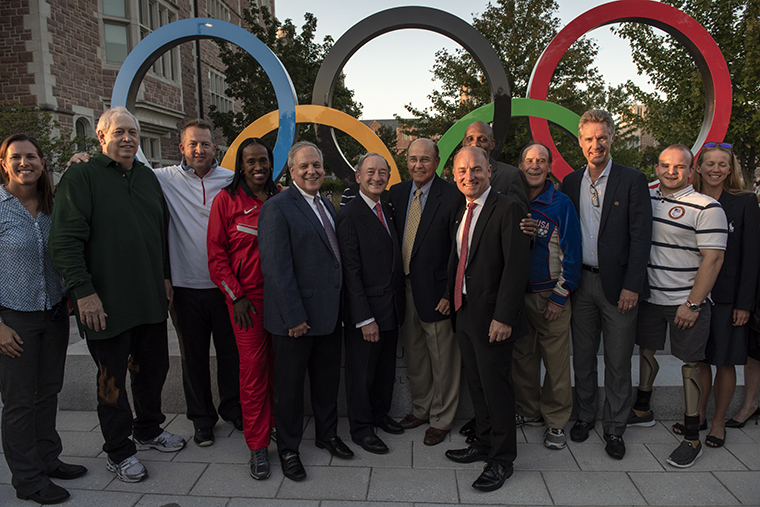
The Olympians added a touch of gold to a ceremony that Viverito called “a celebration of Olympic proportion.” Among the details that would be familiar to Olympic fans was the music provided by the WU Wind Ensemble performing, in addition to “Olympic Fanfare,” the compositions “Bugler’s Dream” and “Olympic Spirit.”
The program opened with an audio recording by longtime NBC Olympic broadcaster Bob Costas, a member of the St. Louis Olympic Legacy Committee, who couldn’t attend the event in person.
Wrighton also noted Washington University’s own athletic tradition as one of the premier programs in NCAA Division III athletics and the notion of the university’s scholar-champions, promoted so well by Azama. “Our student-athletes are always students and scholars first, and yet represent the very best of amateur athletics in the very best and highest sense of that word,” Wrighton said. “Our men and women play for the love of the game and the pride of their university while developing into well-educated leaders in a variety of academic and professional fields.”
Wrighton also announced at the ceremony the intention to rename Francis Field to Francis Olympic Stadium, a move that must be sanctioned by both the United States Olympic Committee and the IOC. “We are working through the final agreement with these entities right now,” Wrighton said, “and we hope to officially make this announcement and celebrate the new name very soon.”
In addition to Wrighton and Viverito, who served as master of ceremonies, remarks were made by Toomey, 50 years after his gold-medal performance in a sport that made its Olympic debut on the track just a few yards away from the podium; and St. Louis attorney Michael Loynd, a 1999 graduate of Washington University School of Law, who is chair of the St. Louis Olympic Legacy Committee. Loynd, along with James “Shad” Schoenke, served as a spark plug to get the sculpture off the ground and played a key role in getting regional stakeholders together to make it happen.
During the program, Loynd presented Wrighton with a replica of the sculpture. “May these rings remind you to never stop dreaming big,” he said.
About the rings
The familiar five-color rings sculpture, known as an Olympic “Spectacular,” is made of stainless steel and sits on a block of granite at the end of Olympian Way, just south of Seigle Hall. Its base replicates an Olympic medal podium, a nod to the St. Louis games being the first to award gold, silver and bronze medals. The entire sculpture, designed by SWT Design and fabricated by Engraphix (both St. Louis companies) spans 16 feet by 9 feet.
Last fall, the Sports Commission’s Olympic Legacy Committee received permission from the IOC to display the rings, one of the most iconic sports symbols in the world, at the venues where the 1904 Summer Games took place. This was a groundbreaking step, as St. Louis previously did not have the ability to use the rings because its games predated their existence.
Their presence adds another jewel to the Danforth Campus, and the turnaround at the end of Olympian Way off Forsyth Boulevard may well become a St. Louis tourist destination. A second Olympic sculpture is planned for Forest Park, site of 1904’s Olympic aquatic events, and the Sports Commission intends to provide programming and other celebrations in honor of the Olympic legacy.
“St. Louis is in exclusive company,” Viverito said. “Our region’s role in the Olympic movement is something to celebrate, and we want to make a transformative difference through the opportunities we have as an Olympic city.”
For now, the sculpture stands on the campus as this first permanent symbol for athletes and dreamers alike, those who will walk past with more than a selfie in mind. After the ceremony, members of the Washington University track team posed in front of the rings with Joyner-Kersee, who generously gave her time following the ceremony to anyone who asked.
Including Gregory Britt, 12-year-old grandson of Sharon Britt, administrative coordinator to the Board of Trustees. Young Gregory boldly challenged Joyner-Kersee to a foot race on the track, which she politely declined. But she did tell him she would watch him run, which she did as he ran the length of the sidewalk from the sculpture to the Gary M. Sumers Recreation Center and back, greeting him when he finished a few minutes later with a high-five.
That the six-time Olympic medalist and world-record holder who was named Sports Illustrated’s Greatest Female Athlete of the 20th Century had time for a young man she had never met speaks volumes about her and the Olympic ideals, ideals that are now permanently on display.
“May I be the first to say, ‘Meet me at the rings,’” Viverito said at the closing of the program.
Read more stories celebrating Washington University’s Olympic legacy here.
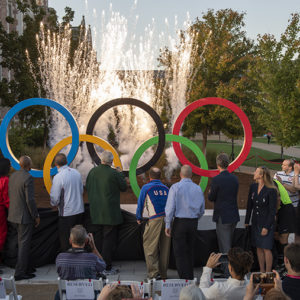
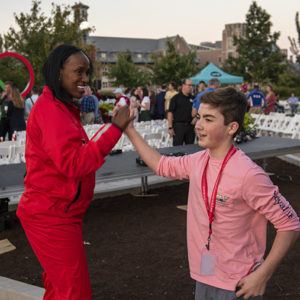
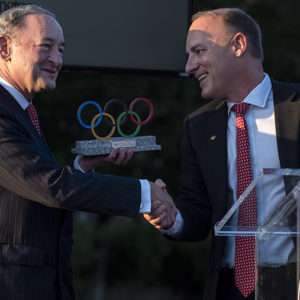
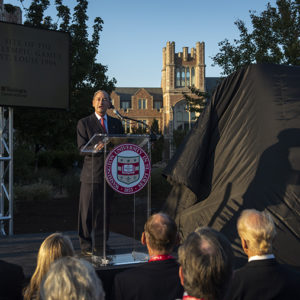
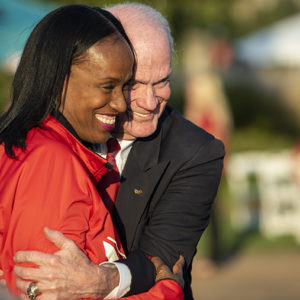
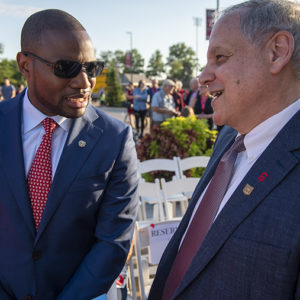
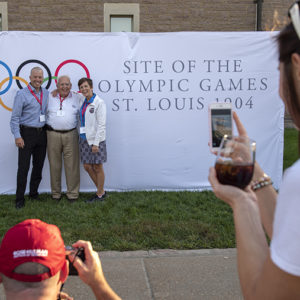
Comments and respectful dialogue are encouraged, but content will be moderated. Please, no personal attacks, obscenity or profanity, selling of commercial products, or endorsements of political candidates or positions. We reserve the right to remove any inappropriate comments. We also cannot address individual medical concerns or provide medical advice in this forum.